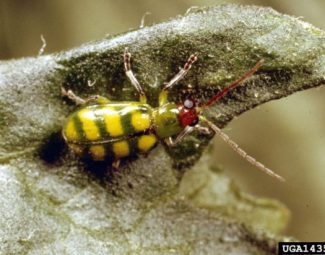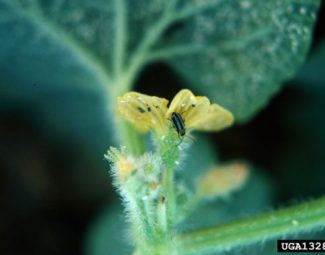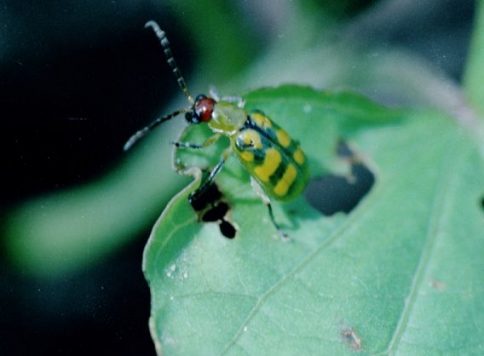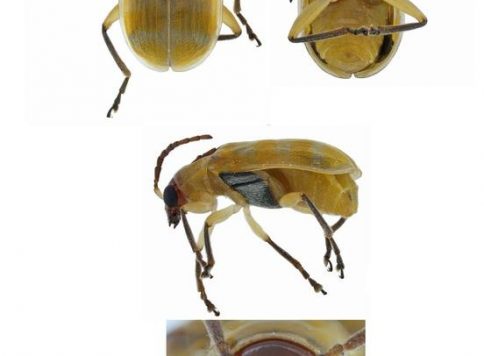Banded Cucumber Beetle
Insect Summary Report
Diabrotica Balteata
General Information
- Banded Cucumber Beetle adult will eat holes in leaves and pods of host plants. Larva feed on roots.
- Primary host plants include melons, cucumber, pumpkins, soybeans, sweet potato, and beans.
- Secondary host preferences are crucifer crops, tomato, cassava, rice, potato, wheat and maize.
- They are a vector of bacterial wilt disease (Erwinia tracheiphila) in most cucurbits and viral diseases in beans.
- Larval feeding increases susceptibility to Fusarium wilt.
- Weed host species include grain amaranth, groundnut, and crownbeard.
- Sex pheromone has been identified that is emitted by female that attracts males.
Life Cycle (35-90 days)
- Eggs… (5-9 Days) Light yellow and oval shaped. Found in clusters of up to 100 beneath the soil around the base of host plants.
- Larva… (11-17 Days) 3/8 in. long. White to pale yellow with a dark head.
- Pupa… (4-6 Days) White or yellow. About ¼ in. long. Develops in the soil.
- Adult… (17-44 Days) About ¼ in. long. Three transverse bands across the width of the back of yellow and green. Mate about 6 days after adult emergence and deposit eggs about 16 days later. Can lay up to 850 eggs/female.
Over-wintering Strategy
Unmated adults over-winter under the protection of insulating material such as leaves, brush, and trash piles during periods of cold temperatures and become active throughout the winter during more moderate temperatures. They do not enter diapause.
Sampling
Yellow sticky traps are commonly used to monitor insect pests. In cucurbits, yellow sticky ribbon can be used for mass trapping of cucumber beetles when placed with cucurbit trap crops. Kairomone lures can enhance the trapping effect.
Organic Control
- General Info
- Heterorhabditis bacteriophora is a commercially available effective predatory nematode of the banded cucumber larva.
- Early planted preferred host such as squash can serve as trap crop. Trap crops can be used in combination with traps and pheromone lures to significantly reduce populations. Monitor and control populations in trap crops to prevent trap crop from becoming source of infestation.
- Commonly Used Products
- Ferti-Neem Oil
- Ferti-Organics Karanja Oil
- Biorepel (Garlic Oil)
- Neemix 4.5 (Botanical
- Pyganic 1.4 (Botanical)
- Pyganic 5.0 (Botanical)
- Various Oils: Trilogy, Tritek, Ecotrol Plus, Cedar
- Soaps: Des-X
- Mycotrol ESO (Biological)
- BoteGHA ES (Biological)
Cultural Control
- Certain varieties of lettuce secrete a form of latex as a reaction to feeding damage that acts as a feeding deterrent.
- Cultivate soil thoroughly to disturb any over-wintering adults in soil.
- In some areas, a strategy is to plant preferred host market crops as late as possible in the spring to force adults that emerge from diapause to go to alternate food sources.
- Plastic row covers to protect plants, especially during early plant development when seedlings are particularly vulnerable.
- Heavy applications of cedar mulch.
- Crop rotation to non host plants.
- Limit, eliminate or treat likely over-wintering sites such as trash and brush piles.
- Eliminate weeds that serve as alternate hosts.
- Remove entire plants that show evidence of bacterial wilt disease.
More Images of the Banded Cucumber Beetle
Bibliography
- Image by Alton N. Sparks, Jr., University of Georgia, Bugwood.org (banded cucumber beetle on flower)
- Images by Russ Ottens, University of Georgia, Bugwood.org (adults on sunflowers)
- Images by Clemson University USDA Cooperative Extension Slide Series, Bugwood.org (adult on leaf and adult on rock)
- Image by Greg Bartman, USDA APHIS PPQ, Bugwood.org (multiple views)
- http://creatures.ifas.ufl.edu/veg/bean/banded_cucumber_beetle.htm (life cycle, predatory nematode)
- http://ohioline.osu.edu/hyg-fact/2000/2139.html (life cycle)
- http://flyaqis.mov.vic.gov.au/padil/D_balteata.htm (host plants)
- Saba F. 1970. Host plant spectrum and temperature limitations of Diabrotica balteata. Canadian Entomologist 102:684-691.(Over-wintering)
- Schalk, J.M.; McLaughlin, J.R.; Tumlinson J.H.; Field Response of Feral Male Banded Cucumber Beetles to the Sex Pheromone 6, 12-Dimethylpentadecan-2-One; The Florida Entomologist, Vol. 73, No.2 (Jun., 1990), pp. 292-297.
- Amit Sethi, Entomological Society of America, Banded cucumber beetle (Coleoptera: Chrysomelidae) resistance in romaine lettuce: Understanding latex chemistry et. al., Monday, December 10, 2007 – 9:17 AM 0526 University of Florida, Department of Entomology & Nematology, PO Box 110620, Gainesville, FL.
- Creighton CS, Fassuliotis F. 1985. Heterorhabditis sp. (Nematoda: Heterorhabditidae): a nematode isolated from the banded cucumber beetle Diabrotica balteata. Journal of Nematology 17:150-153.
- http://www.agrisk.umn.edu/cache/arl02957.htm (sampling/trapping)






